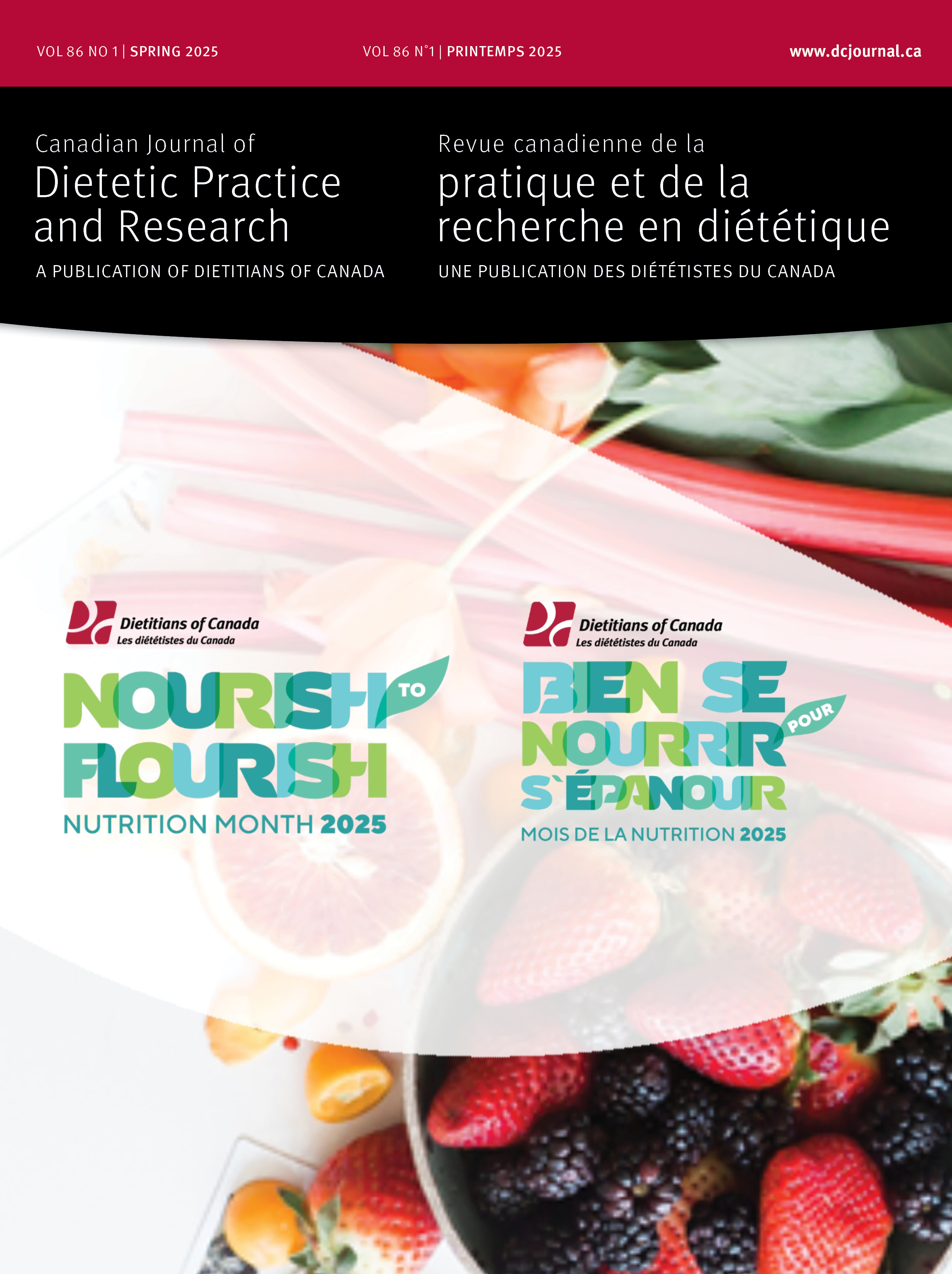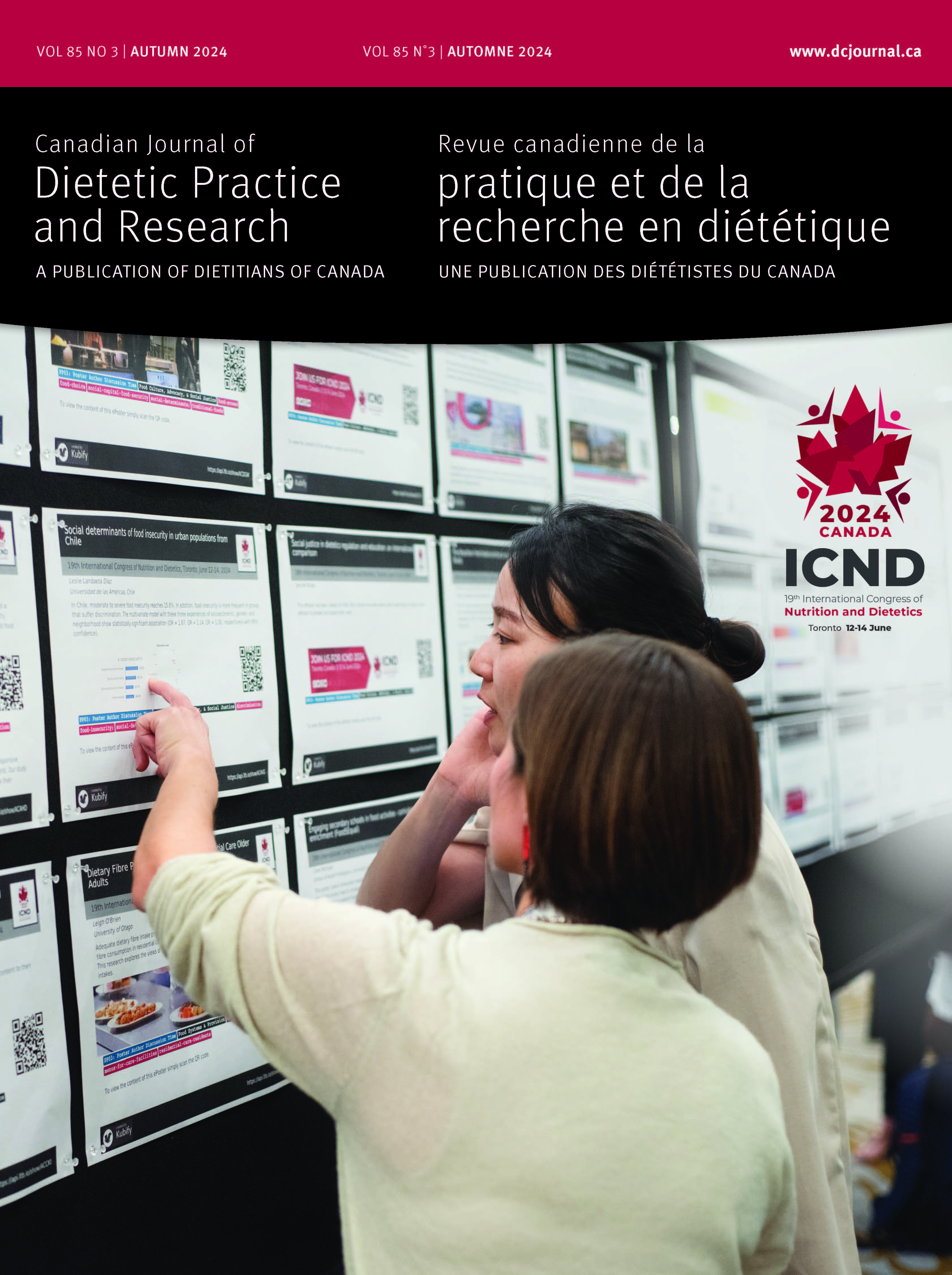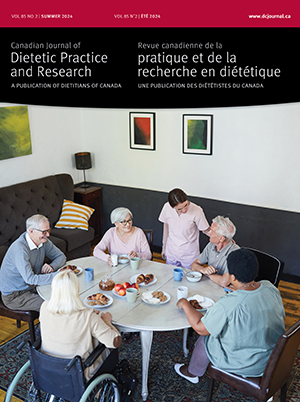Volume 81 • Number 4 • December 2020
Editor’s Message
Research
Purpose: Validated methods to assess diet of non-European infants are sparse. We assessed the validity and reliability of a semi-quantitative food-frequency questionnaire (FFQ) for South Asian infants in Canada.Methods: We developed an 80-item FFQ to assess infant nutrient intake in the South Asian Birth Cohort study (START). Caregivers completed the FFQ twice along with two 24-hour diet recalls. We measured infant plasma ferritin to cross-validate reported iron intake. We evaluated validity using Spearman’s rho (ρ), and reliability using the intraclass correlation coefficient.Results: Seventy-six caregivers provided 2 FFQs and 2 24-hour diet recalls. Energy-adjusted, de-attenuated correlations between the FFQs and 24-hour diet recalls ranged from −0.29 (monounsaturated fat) through 1.00 (cholesterol). The FFQ overestimated energy intake by 128%. Iron intake by 24-hour diet recalls correlated with plasma ferritin (r = 0.41; P = 0.01; n = 37), but iron intake by FFQ did not. The average reproducibility coefficient of the FFQ ranged from 0.24 (macronutrients) to 0.65 (minerals).Conclusions: Among South Asian infants living in Canada, at least 2 days of diet recall completed with the primary caregiver yields more valid and reproducible estimates of nutrient intakes than a semi-quantitative FFQ, and it highlights that careful selection of FFQ portion sizes is important for assessing dietary intake with an FFQ.
Purpose: Consuming nutritious food is essential to learning. The purpose of this research was to determine the diet quality of elementary school lunches, both those in meal programs and those bringing food from home, in urban and rural locations in Saskatchewan.Methods: Using a School Food Checklist and digital photography we compared food group servings and diet quality in 3 school types: urban schools with a meal program and urban and rural schools without a meal program. The total sample was 773 students.Results: Only 55% of students brought the minimum number of servings for grain products and meat and alternatives, with fewer bringing the minimum for vegetables and fruit (25.6%–34.9%), whole grains (24.1%), and milk and alternatives (14.1%). Students bringing food from home had significantly more calories in their lunches from minimally nutritious foods. Students in meal programs had the highest diet quality scores using the Healthy Eating Index adapted for school hours.Conclusions: The diet quality of elementary students’ lunches needs improvement, although students in meal programs have healthier diets. Interventions targeting what children eat at school should focus on increasing the number of students meeting recommendations for healthy foods while decreasing minimally nutritious foods brought to school.
Purpose: To examine health characteristics of long-term care (LTC) residents prescribed therapeutic diets (promoting or restricting intake of key food components), to determine how these diets influenced intake and whether there were differences in food intake and malnutrition risk between residents with and without restrictive diets.Methods: Secondary analysis of the Making the Most of Mealtimes Study includes 435 residents with no/mild cognitive impairment in 32 LTC homes across 4 provinces. Health records were reviewed for diet prescriptions and other characteristics. Weighed and observed food and fluid consumption over 3 nonconsecutive days determined intake. Bivariate and multivariable linear regressions identified associations between therapeutic diets and intake and key nutrients.Results: Almost half (42%) of participants were prescribed a therapeutic diet. Residents receiving restrictive diets (28%) consumed absolute calories consistent with those receiving a regular diet, but kcal/kg was significantly lower (22.1 ± 5.5 vs 23.6 ± 5.3). Low sodium and weight-promoting diets were the only therapeutic diets associated with their corresponding key nutrient profiles. Restrictive therapeutic diets were not associated with energy or protein intake when adjusting for covariates.Conclusions: Restrictive therapeutic diets among those with mild to no cognitive deficits do not appear to impair food intake.
Perspectives in practice
Caregivers of children requiring tube feeding show growing interest in real-food containing formula, including home-blenderized tube feeding (HBTF) and commercial real-food containing formulas (CRFCF). This study aimed to understand caregivers’ perceptions of both. Caregivers using real-food containing tube feeding were recruited through the Feeding Tube Awareness Foundation Facebook group. A 13-question online survey asked about use of HBTF and CRFCF, beliefs about their choices, and what resources guided formula use. Forty-one completed the survey, with mean child age of 7 years. Overall, 54% (n = 22) used HBTF formulas, 34% (n = 14) CRFCF, and 12% (n = 5) used both. For 70% (n = 29), presence of whole foods, nutritional completeness, and natural ingredients were most important. Challenges with CRFCF use included lack of variety (n = 10, 53%) and cost (n = 9, 47%). HBTF challenges were difficulty preparing away from home (n = 19, 70%) and need for special blenders (n = 15, 56%). Participants believed CRFCF are convenient (n = 35, 85%) and nutritionally consistent (n = 25, 61%), but do not contain enough real-food ingredients (n = 26, 63%). Facebook or other social media was the most valued resource guiding formula use (n = 25, 61%). Caregivers desire formulas that are nutritionally complete and made of whole foods. CRFCF offers convenience and consistency, yet caregivers prefer more real-food ingredients.
Prevalence of micronutrient malnutrition is high in individuals living in long-term care (LTC) homes with many individuals consuming low levels of vitamins B6, D, and E; folate; calcium; magnesium; and zinc. The focus of this research was to identify strategies and challenges encountered during development of micronutrient-dense menus for use in Ontario LTC homes and to examine costs associated with development of a menu with acceptable micronutrients. Semi-structured open-ended interviews were conducted with 13 menu planners (7 dietitians, 6 nutrition managers) in diverse LTC homes in Ontario. Data were thematically analyzed. A 7-day hypothetical menu meeting all nutrient requirements was developed and costed. Analysis of the interview data showed that menus are planned according to the Canada’s Food Guide (2007) and focus placed on Dietary Reference Intakes of protein, fibre, calcium, and sodium. Little focus is placed on micronutrients. Flexibility in foods offered was important to accommodate the small volume of food consumed. Resident preferences were balanced against nutritional requirements. Challenges included planning for diverse populations, managing portion sizes, and balancing the budget. A hypothetical menu planned to contain adequate levels of all micronutrients is 49% higher in food costs than the amount currently provided to Ontario LTC homes.
Little is known about athletes’ perceptions of emerging dietary guidance on plant-based diets (PBD). To explore knowledge and perceptions of PBD among competitive and recreational athletes, an online survey was developed, pilot tested, and sent via email to athletes recruited from 2 Canadian post-secondary institutions. Survey questions explored athletes’ understanding and views of the proposed Canadian dietary guidelines emphasizing plant-based proteins. Data were analyzed using grounded theory approaches. Forty-eight athletes participated in the survey. Two major themes emerged: (i) athletes had mixed perceptions of plant-based eating (PBE) and (ii) athletes associated PBE with broader food system concerns. Athletes have the potential to be important advocates of healthy and sustainable eating among peer groups and the general public. For effective promotion of PBE, the unique nutrient requirements and performance goals of athletes should be considered. Messaging to encourage a flexible rather than strict view of PBD may be a more feasible and acceptable approach when working with athletes.
FoodARC is a research hub for community-based participatory research (CBPR) contributing to healthy, just, and sustainable food systems for all. University students, largely from dietetics programs, are engaged as co-learners and research partners. This study explores the contribution of CBPR to student learning on household food insecurity (HFI) and community food security (CFS) and ways to address these issues through practice. Photovoice, an arts-informed 3-phase participatory research process, was used to take pictures that reflected student experiences and insights regarding CBPR. Through a half-day guided discussion, 5 participants shared and discussed their photos and the meanings behind them with other participants and then collectively analyzed and interpreted common themes. Three overarching themes reflecting student learning and development associated with CBPR experiences were identified: students’ expanded understandings of HFI and CFS as well as potential solutions to address these issues, their modeling of participatory ways of working, and applications to future professional practices. Student understandings about HFI and CFS through the integration of a community-engaged learning environment like CBPR results in important learning and personal and professional development. Learning is enriched and students are able to imagine their roles in addressing these issues through practice.
Report
Purpose: To investigate dairy and plant-based dairy alternatives (DPBDA) purchasing habits, including comparisons among locations of purchase and among subtypes of DPBDA, of families with preschool-aged children.Methods: Expenditures on food and DPBDA were calculated using grocery and food receipts collected for 3 weeks from 51 households in and around Guelph, Ontario, Canada. DPBDA were coded by subtypes (alternatives, cheese/yogurt, cow’s milk, cream, and ice cream/other) and by locations of purchase, which were coded as big-box, discount, high-end, local/other, and midrange stores. Logistic regression using generalized estimating equations was used to investigate odds of purchasing DPBDA by location of purchase. All models included family income and number of children as potential confounders.Results: Ninety-eight percent of families purchased cheese/yogurt, 92% purchased cow’s milk, and 35% of families purchased plant-based dairy alternatives. Families were more likely to purchase DPBDA from big-box stores than discount, midrange, or local/other stores (P < 0.01) and were more likely to purchase cheese/yogurt than dairy alternatives, cream, or ice cream/other subtypes (P < 0.01). Odds of purchasing were not different between cheese/yogurt and cow’s milk.Conclusion: Families’ DPBDA purchasing habits differ by purchase location and subtype. Further research is warranted to understand the factors affecting these purchasing habits.










